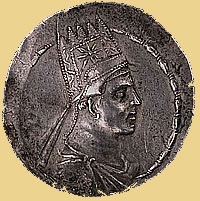Glossary (Armavir-Ashot I)
Armavir
One of the oldest Armenian cities situated in the western part of the Ararat valley. Founded by King Argiste I and first known as Argistehinili, Armavir was reconstructed in the Hellenistic period. The city was known as Hoktemberian, during the Soviet era up to 1992, and Sardarapat before 1932.
Armenian Church
 St.Gregory baptizing the Armenian nation, by Ivan Aivazovsky, 1892
St.Gregory baptizing the Armenian nation, by Ivan Aivazovsky, 1892
Founded in the late 3d-early 4th centuries by Gregory the Illuminator, the Armenian Church is also known as the Armenian Apostolic Church due to the activity and martyrdom of the Apostles Thaddeus and Bartholomew in Armenia. Sometimes the name Gregorian is applied in relation of St.Gregory the Illuminator.
In 301, Armenia became the first Christian country in the world history. In the beginning of the 5th century, Christianity strengthened considerably after the translation of the Bible into Armenian. In 451, the Armenian Church isolated itself from the rest of the Christian Church after rejecting the formula of the Council of Chalcedon about the nature of Jesus Christ.
Armenian Apostolic Church Library Online – www.ArmenianChurchLibrary.com
Arsacids
(Arshakuni) Dynasty of Armenian kings that ruled from 149 BC to AD 428. They originally descended from the Parthian branch of Arsacids, but became a distinct Armenian dynasty.
Arshak I
King of Armenia (127-114 BC), son of Vagharshak I and father of Artashes. He launched two successful military campaigns against the Kingdom of Pontus.
Arshak II
King of Armenia (363-381). Bellicose and tyrant, he waged relentless wars against the revolted Armenian lords. He butchered the influential Kamsarakan family, and executed many of the rebelled nobles. The Persian King Shapur II summoned him to Persia, arrested him and imprisoned in the Castle of Oblivion, where he died.
Artashat
(Artaxata), city on Araks River in the Ararat valley, founded by Artashes in 166 BC. Strabo and Plutarch described it as a large and beautiful city, terming it as the Armenian Carthage. Until the 5th century, Artashat was the principal political and cultural center of Armenia.
Artashes I
Ruler of Armenia in 189-159 BC. He revolted against the Seleucid king Antiochus the Great and proclaimed the independence of Armenia. He built the city of Artashat (Artaxata) on the Araks River. He is mentioned in the works of Strabo and Plutarch.
Artashes II
King of Armenia (114-89 BC). Moses of Khorene attributes many glorious victories to him, which is in conflict with Greek primary sources. Perhaps, some of the deeds of Tigranes the Great, his illustrious successor, were erroneously ascribed to Artashes II.
Artavazd II
 Artavazd II. Inscription on the back side of the coin title Artavazd as King of Kings.
Artavazd II. Inscription on the back side of the coin title Artavazd as King of Kings.
Also: Artavazdes II, King of Armenia (53-34 BC), son of Tigranes the Great. He made alliance with the Parthian King Orontes to fight against Rome. The united Armenian and Parthian forces routed Licinius Crassus in the battle of Carrhae, but during the new war the Armenian King was captured by Markus Antoninus, taken to Egypt and executed. Artavazd was known as a Greek art adept, he composed dramas and poetry.
Artaz
Historical canton of Vaspurakan province in ancient and medieval Armenia (now in Turkey). According to Moses of Khorene, Artaz was initially Shavarshan. The most famous place in Artaz region is Avarayr, battlefield of the Armenian nobles against the Persians in 451.
Artsakh
One of 15 provinces or ashkhars (“worlds”) of the Greater Armenia, Artsakh consisted of 14 cantons: Mius Haband, Vakunik, Berdadzor, Metskuank, Metzirank, Harchilank, Mukhank, Piank, Patskank, Sisakan, Kotak, Kusti Parnes, Koght and Tsar.
Artsruni
Also: Ardzruni, Ancient Armenian noble family, dynasty of Armenian princes and kings. They ruled in Vaspurakan province until 1021.They are said to be descent from the sons of King Sennacherib of Assyria, who, according to Old Testament (2 Kings, 19:37), killed their father and then escaped to Armenia.
ASALA
Armenian Secret Army for the Liberation of Armenia. ASALA was formed in the early 1970s with a stated objective to compel the Turkish Government to acknowledge responsibility for the massacres of 1915-1921. In 1975-1983, the fighters of ASALA were involved in terrorist activities against the representatives of the Turkish embassies in different European countries.
Ashkhar
(Armenian for World) The Armenians called so the provinces of the Greater Armenia. Traditionally, there were 15 ahkhars or worlds: Ayrarat, Turuberan, Vaspurakan, Siunik, Higher Armenia, Forth Armenia, Aghdznik, Mokk, Korchek, Persian Armenia, Paytakaran, Artsakh, Outik, Gugark and Tayk.
Ashot I
King of Armenia (885-890) and founder of royal Bagratouni dynasty. He became Sparapet of Armenia in 855, and was proclaimed Prince of the Princes in 858. He pleaded the Caliph to release the Armenian nobles imprisoned in Bagdad. His authority in Armenia increased to the point that the Armenian grandees recognized him King of Armenia. In 885, both the Caliph and the Byzantine Emperor sent him a crown, recognizing his rule. He died in 890 and was succeeded by Sembat I.







